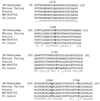Molecular basis for attenuation of neurovirulence of a yellow fever Virus/Japanese encephalitis virus chimera vaccine (ChimeriVax-JE)
- PMID: 11134306
- PMCID: PMC113989
- DOI: 10.1128/JVI.75.2.934-942.2001
Molecular basis for attenuation of neurovirulence of a yellow fever Virus/Japanese encephalitis virus chimera vaccine (ChimeriVax-JE)
Abstract
A yellow fever virus (YFV)/Japanese encephalitis virus (JEV) chimera in which the structural proteins prM and E of YFV 17D are replaced with those of the JEV SA14-14-2 vaccine strain is under evaluation as a candidate vaccine against Japanese encephalitis. The chimera (YFV/JEV SA14-14-2, or ChimeriVax-JE) is less neurovirulent than is YFV 17D vaccine in mouse and nonhuman primate models (F. Guirakhoo et al., Virology 257:363-372, 1999; T. P. Monath et al., Vaccine 17:1869-1882, 1999). Attenuation depends on the presence of the JEV SA14-14-2 E protein, as shown by the high neurovirulence of an analogous YFV/JEV Nakayama chimera derived from the wild JEV Nakayama strain (T. J. Chambers, A. Nestorowicz, P. W. Mason, and C. M. Rice, J. Virol. 73:3095-3101, 1999). Ten amino acid differences exist between the E proteins of ChimeriVax-JE and the YFV/JEV Nakayama virus, four of which are predicted to be neurovirulence determinants based on various sequence comparisons. To identify residues that are involved in attenuation, a series of intratypic YFV/JEV chimeras containing either single or multiple amino acid substitutions were engineered and tested for mouse neurovirulence. Reversions in at least three distinct clusters were required to restore the neurovirulence typical of the YFV/JEV Nakayama virus. Different combinations of cluster-specific reversions could confer neurovirulence; however, residue 138 of the E protein (E(138)) exhibited a dominant effect. No single amino acid reversion produced a phenotype significantly different from that of the ChimeriVax-JE parent. Together with the known genetic stability of the virus during prolonged cell culture and mouse brain passage, these findings support the candidacy of this experimental vaccine as a novel live-attenuated viral vaccine against Japanese encephalitis.
Figures



Similar articles
-
Single mutation in the flavivirus envelope protein hinge region increases neurovirulence for mice and monkeys but decreases viscerotropism for monkeys: relevance to development and safety testing of live, attenuated vaccines.J Virol. 2002 Feb;76(4):1932-43. doi: 10.1128/jvi.76.4.1932-1943.2002. J Virol. 2002. PMID: 11799188 Free PMC article.
-
A molecularly cloned, live-attenuated japanese encephalitis vaccine SA14-14-2 virus: a conserved single amino acid in the ij Hairpin of the Viral E glycoprotein determines neurovirulence in mice.PLoS Pathog. 2014 Jul 31;10(7):e1004290. doi: 10.1371/journal.ppat.1004290. eCollection 2014 Jul. PLoS Pathog. 2014. PMID: 25077483 Free PMC article.
-
Chimeric yellow fever virus 17D-Japanese encephalitis virus vaccine: dose-response effectiveness and extended safety testing in rhesus monkeys.J Virol. 2000 Feb;74(4):1742-51. doi: 10.1128/jvi.74.4.1742-1751.2000. J Virol. 2000. PMID: 10644345 Free PMC article.
-
Phenotypic and genotypic characteristics of Japanese encephalitis attenuated live vaccine virus SA14-14-2 and their stabilities.Vaccine. 2010 May 7;28(21):3635-41. doi: 10.1016/j.vaccine.2010.02.105. Epub 2010 Mar 11. Vaccine. 2010. PMID: 20226891 Review.
-
IMOJEV(®): a Yellow fever virus-based novel Japanese encephalitis vaccine.Expert Rev Vaccines. 2010 Dec;9(12):1371-84. doi: 10.1586/erv.10.139. Expert Rev Vaccines. 2010. PMID: 21105774 Review.
Cited by
-
Japanese encephalitis: the virus and vaccines.Hum Vaccin Immunother. 2014;10(2):263-79. doi: 10.4161/hv.26902. Epub 2013 Oct 25. Hum Vaccin Immunother. 2014. PMID: 24161909 Free PMC article. Review.
-
Japanese encephalitis virus neuropenetrance is driven by mast cell chymase.Nat Commun. 2019 Feb 11;10(1):706. doi: 10.1038/s41467-019-08641-z. Nat Commun. 2019. PMID: 30742008 Free PMC article.
-
Biological and genetic properties of SA₁₄-14-2, a live-attenuated Japanese encephalitis vaccine that is currently available for humans.J Microbiol. 2012 Aug;50(4):698-706. doi: 10.1007/s12275-012-2336-6. Epub 2012 Aug 25. J Microbiol. 2012. PMID: 22923123
-
Tick-Borne Encephalitis Virus Structural Proteins Are the Primary Viral Determinants of Non-Viraemic Transmission between Ticks whereas Non-Structural Proteins Affect Cytotoxicity.PLoS One. 2016 Jun 24;11(6):e0158105. doi: 10.1371/journal.pone.0158105. eCollection 2016. PLoS One. 2016. PMID: 27341437 Free PMC article.
-
Biomarkers in Japanese encephalitis: a review.Biomed Res Int. 2013;2013:591290. doi: 10.1155/2013/591290. Epub 2013 Dec 18. Biomed Res Int. 2013. PMID: 24455705 Free PMC article. Review.
References
-
- Aihara S, Chunming R, Yong-Xin Y, Lee T, Watanabe K, Komiya T, Sumiyoshi H, Hashimoto H, Nomoto A. Identification of mutations that occurred on the genome of Japanese encephalitis virus during the attenuation process. Virus Genes. 1991;5:95–109. - PubMed
-
- Berg S W, Mitchell B S, Hanson R K, Olafson R P, Williams R P, Tueller J E, Burton R J, Novak D M, Tsai T F, Wignall F S. Systemic reactions in U.S. marine corps personnel who received Japanese encephalitis vaccine. Clin Infect Dis. 1997;24:265–266. - PubMed
-
- Cecilia D, Gould E A. Nucleotide changes responsible for loss of neuroinvasiveness in Japanese encephalitis virus neutralization-resistant mutants. Virology. 1991;181:70–77. - PubMed
Publication types
MeSH terms
Substances
Grants and funding
LinkOut - more resources
Full Text Sources
Other Literature Sources

